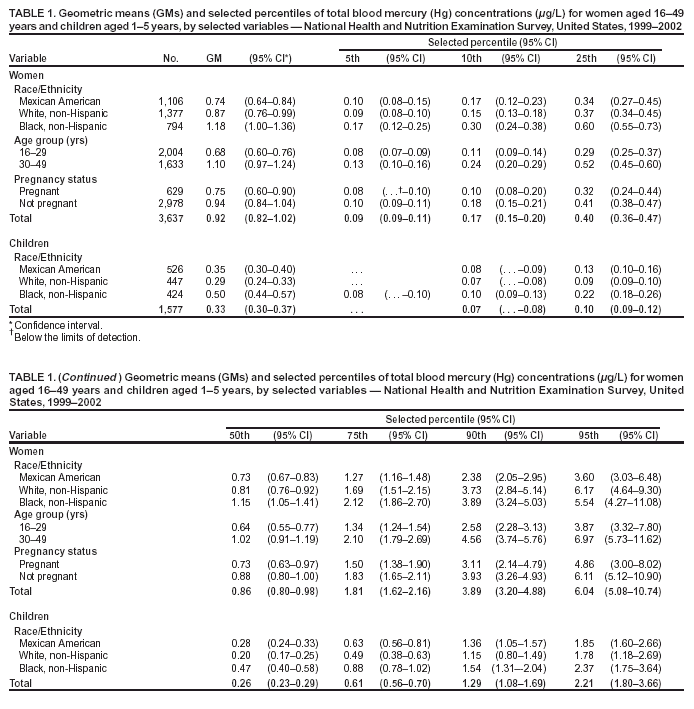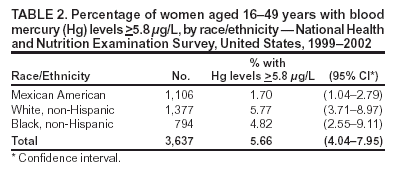 |
|
|
|
|
|
|
| ||||||||||
|
|
|
|
|
|
|
||||
| ||||||||||
|
|
|
|
|
Persons using assistive technology might not be able to fully access information in this file. For assistance, please send e-mail to: mmwrq@cdc.gov. Type 508 Accommodation and the title of the report in the subject line of e-mail. Blood Mercury Levels in Young Children and Childbearing-Aged Women --- United States, 1999--2002Exposure to high levels of mercury (Hg) can cause neurologic and kidney disorders (1--3). Because methylated Hg (methyl-Hg) in the aquatic environment accumulates in animal tissues up the food chain, persons in the United States can be exposed by eating freshwater fish, seafood, and shellfish. Exposure of childbearing-aged women is of particular concern because of the potential adverse neurologic effects of Hg in fetuses. To determine levels of total blood Hg in childbearing-aged women and in children aged 1--5 years in the United States, CDC's National Health and Nutrition Examination Survey (NHANES) began measuring blood Hg levels in these populations in 1999. This report summarizes NHANES results for 1999--2002 and updates previously published information (4,5). The findings confirmed that blood Hg levels in young children and women of childbearing age usually are below levels of concern. However, approximately 6% of childbearing-aged women had levels at or above a reference dose, an estimated level assumed to be without appreciable harm (>5.8 µg/L). Women who are pregnant or who intend to become pregnant should follow federal and state advisories on consumption of fish. NHANES is a continuous survey of the health and nutritional status of the civilian, noninstitutionalized U.S. population; data are released and reported in 2-year cycles (6). Each participant undergoes a household interview and a physical examination. During the physical examination, blood is collected by venipuncture from all persons aged >1 year. For this analysis, whole-blood specimens were analyzed for total and inorganic Hg for children aged 1--5 years and women aged 16--49 years by automated, cold-vapor atomic absorption spectrophotometry in CDC's inorganic toxicology laboratory. The analytic method detection limit was 0.14 µg/L (ppb) for total Hg and 0.4 µg/L (ppb) for inorganic Hg (7). Blood Hg levels less than the limit of detection were assigned a value equal to the detection limit divided by the square root of 2 for the calculation of geometric mean (GM) values. During 1999--2002, the GMs of total blood Hg concentrations for all childbearing-aged women and for children aged 1--5 years were 0.92 µg/L and 0.33 µg/L, respectively; the 95th percentiles of blood Hg for women and children were 6.04 µg/L and 2.21 µg/L, respectively (Table 1). The percentage of all women aged 16--49 years with Hg levels >5.8 µg/L (the Environmental Protection Agency's [EPA] Reference Dose [RfD]) was 5.66% (95% confidence interval [CI] = 4.04--7.95) (Table 2). Among children aged 1--5 years, the estimated percentage who had blood Hg levels >5.8 µg/L during 1999--2002 could not be reported because the observed percentage was too low for the given sample size to calculate a statistically reliable national population estimate. Almost all inorganic blood Hg levels were undetectable, indicating that total blood Hg greater than or equal to the EPA RfD mostly reflected exposure to organic Hg (especially methyl-Hg). Reported by: RL Jones, PhD, T Sinks, PhD, SE Schober, PhD, M Pickett, MPH, National Center for Environmental Health; National Center for Health Statistics, CDC. Editorial Note:This report updates NHANES 1999--2000 estimates of blood Hg levels (5), the first nationally representative estimates of U.S. women's and children's exposures to Hg based on biologic measures. The findings indicate that blood Hg levels in young children and childbearing-aged women usually are below levels of concern. Among childbearing-aged women, for the 4-year period 1999--2002, estimates of the GM of blood Hg and the proportion with levels >5.8 µg/L were lower than estimates for the 2-year period 1999--2000, reflecting apparent declines in these values for the 2-year period 2001--2002. However, when these differences were evaluated by comparing estimates for the two 2-year periods, the declines were not statistically significant: the GM of blood Hg for 2001--2002 was 0.83 µg/L (CI = 0.73--0.93), compared with 1.02 µg/L (CI = 0.80--1.24) for 1999--2000, and the percentage of women with blood Hg levels >5.8 µg/L was 3.9% in 2001--2002 (CI = 2.40--6.43), compared with 7.8% in 1999--2000 (CI = 4.70--12.83). At least 2 more years of data are needed to best determine whether Hg exposure has declined among women of childbearing age in the United States. Although NHANES data are released and often analyzed as 2-year periods, the estimates of blood Hg levels for 1999--2002 are the most reliable estimates of current exposure. The 4-year period provides greater geographic coverage, and estimates and sample errors are more stable, thus reducing variability caused by differing exposures to Hg across survey site locations. Accordingly, the National Center for Health Statistics advises users of these data that the most reliable estimates of current exposure are obtained when the 1999--2002 data are analyzed together (6). The EPA RfD is based on measures of Hg in cord blood and is a level assumed to be without appreciable harm. The RfD was determined by applying an uncertainty factor of 10 to a dose (58 µg/L) that was the lower 95% confidence limit of a dose associated with an increased proportion of abnormal scores on the Boston Naming Test for children exposed in utero (2). All women and children in the 1999--2002 NHANES survey period had blood Hg levels below 58 µg/L. The harm to a fetus from levels of exposure as measured by cord blood levels between 5.8 µg/L and 58 µg/L is uncertain. The findings in this report are subject to at least two limitations. First, NHANES does not include an adequate sampling of women (e.g., sport fishers) who might eat large amounts of fish to characterize the distribution of total blood Hg in this group. Second, the ratio of Hg in cord to maternal blood (i.e., equivalent to NHANES measures) is uncertain (2,8). Therefore, NHANES values might not be directly comparable to the EPA RfD, which is based on cord blood Hg levels. Fish are an important part of a diet, high in protein and nutrients and low in saturated fatty acids and cholesterol. The short-term strategy to reduce Hg exposure is to eat fish with low Hg levels and avoid or reduce consumption of fish with high Hg levels. Because exposure to methyl-Hg can harm fetuses, the Food and Drug Administration (FDA) advises that women who are or might become pregnant not eat shark, swordfish, king mackerel, and tile fish (9). In addition, EPA and the Agency for Toxic Substances and Disease Registry have established daily consumption levels of Hg considered to be without harm (1). State-based fish advisories and bans identify fish species contaminated by Hg and their locations and provide safety advice (10). The NHANES program continues to collect Hg measurements in human tissue to monitor the effectiveness of efforts to reduce Hg exposure in the U.S. population. References
Table 1  Return to top. Table 2  Return to top.
Disclaimer All MMWR HTML versions of articles are electronic conversions from ASCII text into HTML. This conversion may have resulted in character translation or format errors in the HTML version. Users should not rely on this HTML document, but are referred to the electronic PDF version and/or the original MMWR paper copy for the official text, figures, and tables. An original paper copy of this issue can be obtained from the Superintendent of Documents, U.S. Government Printing Office (GPO), Washington, DC 20402-9371; telephone: (202) 512-1800. Contact GPO for current prices. **Questions or messages regarding errors in formatting should be addressed to mmwrq@cdc.gov.Page converted: 11/4/2004 |
|||||||||
This page last reviewed 11/4/2004
|